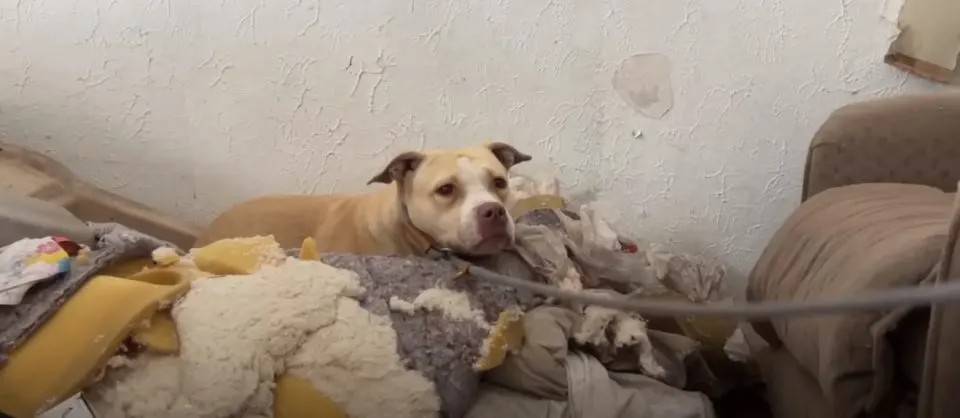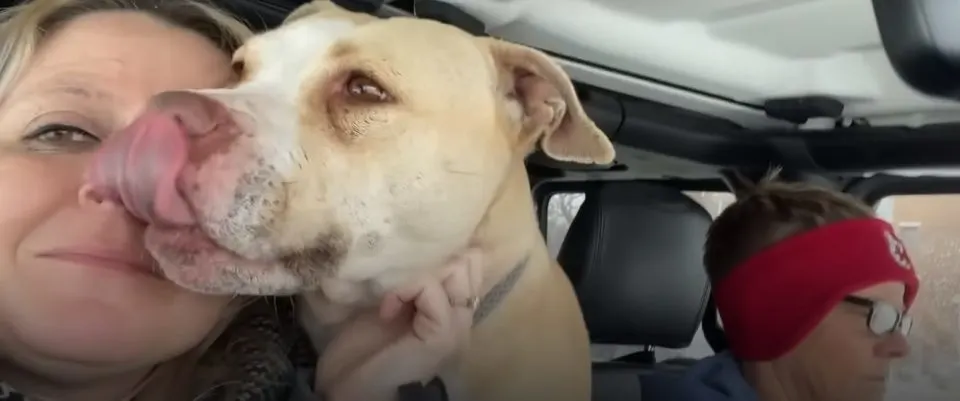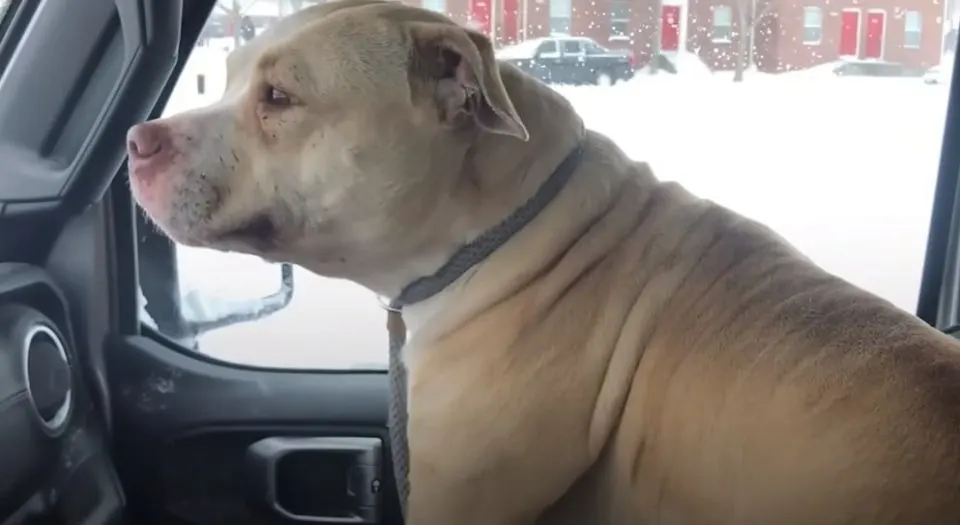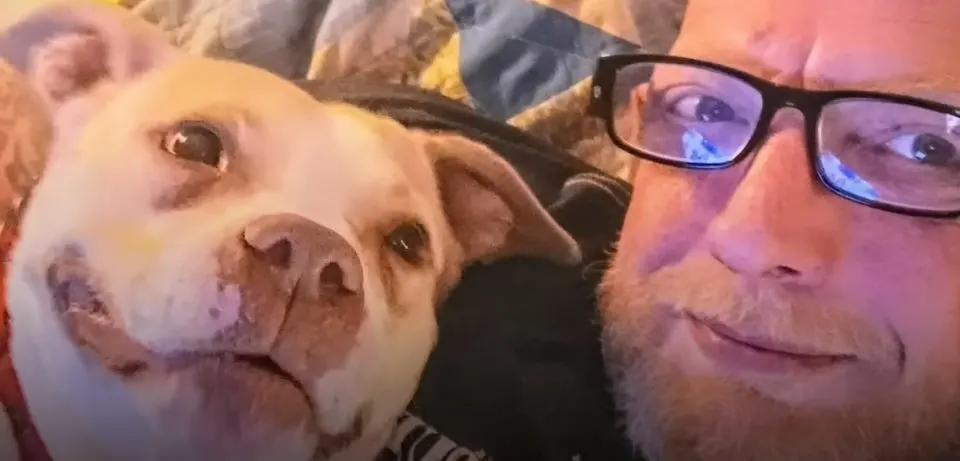When Donna, from Stray Rescue of St. Louis, came across a row of abandoned houses in the St. Louis area, she thought to herself how this would be the perfect hiding place for scared and abandoned dogs.
Deciding to investigate the houses a bit, Donna soon found a little Pittie in need of her help!
Rescue Mission

At first, she thought it would be best if she set a trap and waited for the doggo to enter it on his own.
However, when Donna noticed that the little Pittie wasn’t coming out, she went to the back of the house, and what she saw shocked her a bit.
“There were actually footprints going up into the house. So she had to have gotten to the top of the steps and then pretty much jumped into the house,” said Donna.
Thinking it was a bit dangerous for them to jump across the broken-in stairs, Donna started to look for a safer way in.
They soon found out that they could get inside the house through the basement and start looking for the dog.
There was, like, a broken pipe, so pretty much assumed she wasn’t going to be hanging out down there.
Donna then went up the stairs trying to locate her, but when she climbed to the second floor and saw that there was no sign of the dog, she started losing hope.
However, as soon as she got to the third floor, she noticed a little head peeking out of the trash.

Donna slowly approached her, talking to her in a gentle voice and telling her that they were there to save her.
She let me get a leash on her. She was a little hesitant at first, I gave her a little tug and she started following me and we went down.

Once they got out of the house, they made their way over to the car and the little Pittie was more than happy to get in.
On her way to the St. Louis rescue, this doggo just couldn’t keep in her excitement.

She decided to shower Donna and her team in kisses, showing them just how much she appreciated what they were doing for her.
The aggressive pit bull mindset is just not true. They’re the sweetest, most loving dogs.
New Life
When they got to the shelter, the staff immediately searched the dog for a microchip.
After not finding one, they put up the sweet Pittie for adoption, knowing that a warm and loving home would do her some good.

In no time, a family reached out, wanting this little doggo as a new member of their team.
Being surrounded by so much love and adoration, this pup turned her frown upside down and is now the cutest and sweetest little girl ever.

If you’ve noticed an increase in your furry friend’s toots lately, you’re not alone. Dog farts can be quite the stinky surprise, leaving you wondering what’s causing this gassy situation. As a seasoned dog enthusiast, you’re well aware that canine flatulence is a common occurrence, but when it becomes more frequent than usual, it’s time to sniff out the root cause.
Your canine companion’s excessive gas may be linked to various factors, from dietary indiscretions to underlying health issues. Understanding why your dog is emitting these odorous emissions can help you address the problem and restore fresh air to your living space. So, if you’re wondering why your dog’s backside is becoming a mini methane factory, let’s embark on a journey to uncover the reasons behind their increased flatulence.
Understanding Why Your Dog Is Farting So Much
The Digestive System of Dogs
Dogs’ digestive systems break down food just like yours. When food isn’t fully digested in the small intestine, it moves into the large intestine where bacteria break it down, producing gases like hydrogen, methane, and carbon dioxide. If there’s an imbalance in your dog’s gut flora, it can lead to increased flatulence.
- Dietary Factors: Your dog’s diet plays a significant role in their flatulence levels. Foods high in fiber, dairy products, or sudden diet changes can cause excess gas. Pay attention to what you feed your furry friend.
- Eating Habits: Rapid eating or scavenging can lead to swallowing excess air, which results in more frequent flatulence. Encourage slow, measured eating to reduce this issue.
- Underlying Health Conditions: Sometimes, excessive farting could signal an underlying health problem like gastrointestinal issues, food intolerance, or infections. If you notice any unusual symptoms accompanying the flatulence, consult your veterinarian.
- Age and Breed: Certain dog breeds are more prone to flatulence due to their anatomy, while age can also play a role. Puppies and senior dogs might experience more gas due to their digestive processes.
Diet and its Role in Canine Flatulence
Identifying Food Sensitivities and Allergies
If your furry friend is gassy, it could be due to food sensitivities or allergies. Some dogs may struggle to digest certain ingredients like grains, dairy, or soy, leading to increased flatulence. Look for common signs such as itching, skin issues, or gastrointestinal upset after meals to pinpoint potential food culprits.
The Impact of a Low-Quality Diet
What your dog eats directly affects their gas production. Low-quality dog foods with fillers, artificial ingredients, or excessive fat content can disrupt digestion, resulting in more gas. Opt for high-quality, balanced diets rich in protein, fiber, and essential nutrients to support your dog’s digestive health and reduce flatulence.
Beneficial Foods for Reducing Gas
Certain foods can help alleviate your dog’s gas issues. Incorporating ingredients like plain boiled chicken, pumpkin, or yogurt (if tolerated) into their diet can promote better digestion and reduce flatulence. These gentle, easily digestible foods can aid in soothing your dog’s stomach and minimizing excessive gas buildup.
Health-Related Causes of Increased Flatulence
Gastrointestinal Diseases and Disorders
Digestive issues like inflammatory bowel disease (IBD), pancreatitis, or intestinal infections can lead to excessive gas in dogs. These conditions disrupt the normal digestion process, causing flatulence. If your dog’s flatulence is persistent and accompanied by other symptoms like diarrhea or vomiting, consult your veterinarian for proper diagnosis and treatment.
The Role of Parasites and Worms
Parasites such as giardia or worms like roundworms can also contribute to increased flatulence in dogs. These internal parasites disrupt the intestinal function, leading to gas production. Regular deworming and preventive measures advised by your vet can help control parasitic infestations and reduce flatulence in your furry friend.
How Lifestyle Influences Canine Flatulence
The Effects of Eating Habits
Your dog’s eating habits play a significant role in their flatulence levels. When your furry friend gulps down their food quickly or eats too much, they may swallow excess air, leading to increased gas. To reduce this, consider using slow-feeder bowls or feeding smaller, more frequent meals to prevent excessive air intake. Additionally, ensure your dog doesn’t have access to table scraps or foods that can cause digestive issues, resulting in gas.
Solutions and Remedies for Excessive Dog Farting
Diet Adjustments and Proper Nutrition
To tackle your dog’s excessive farting, start by making some simple adjustments to their diet. Opt for high-quality, balanced meals to reduce gas production. Identify any potential food sensitivities by monitoring their reaction to different ingredients. Consider consulting a vet for specialized dietary recommendations tailored to your dog’s needs.
Probiotics and Supplements for Digestive Health
Probiotics and digestive supplements can help regulate gut flora and improve digestion, reducing your dog’s flatulence. Adding these to your dog’s daily routine can promote gut health and minimize excessive gas production. Remember to follow recommended dosage instructions to ensure their effectiveness.
When to Consult Your Veterinarian
If your dog’s farting issue persists or is accompanied by other concerning symptoms, it’s crucial to seek professional help. A veterinarian can conduct a thorough examination to diagnose any underlying health conditions contributing to the problem. They can recommend specific treatments, such as addressing gastrointestinal issues or parasitic infections, to alleviate your dog’s discomfort. Regular veterinary check-ups and preventive measures can also play a significant role in controlling flatulence in dogs.
Conclusion
So, there you have it – the mystery of your gassy pup unveiled! Understanding the reasons behind your dog’s excessive farting is the first step to tackling this smelly issue. By making simple adjustments to their diet, monitoring their food sensitivities, and seeking advice from a vet, you can help your furry friend pass wind less frequently. Remember, a balanced diet, proper feeding habits, and regular vet check-ups are key to keeping your dog’s flatulence under control. With a little bit of care and attention, you can say goodbye to those stinky moments and enjoy a more pleasant atmosphere at home. Your dog will thank you, and your nose will too!
Frequently Asked Questions
Q: What causes increased dog flatulence?
A: Increased dog flatulence can be caused by dietary choices, eating habits, health conditions, age, and breed differences leading to imbalances in gut flora.
Q: How can diet influence canine flatulence?
A: Diet can influence canine flatulence by identifying potential food culprits causing sensitivities and incorporating high-quality, balanced diets to reduce gas production.
Q: What lifestyle factors impact canine flatulence?
A: Lifestyle factors like eating habits can impact canine flatulence levels. Using slow-feeder bowls and feeding smaller, more frequent meals can prevent excess air intake and reduce flatulence.
Q: What are the solutions for excessive dog farting?
A: Solutions for excessive dog farting include diet adjustments for reduced gas production, monitoring food sensitivities, using probiotics, consulting a vet for specialized dietary recommendations, and addressing underlying health conditions with regular veterinary check-ups.
[no_toc]

Hey there, I’m Janet Brooks, a dog-loving student from California. I’m all about helping pups in need, especially those without homes. Me and my awesome friends work together to give shelter and love to stray dogs. Oh, and I also write blogs about dogs to share helpful info.